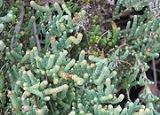
Tecticornia pergranulata
Encyclopedia
Tecticornia pergranulata (commonly known as the Blackseed Glasswort or Blackseed Samphire) is a succulent halophyte plant species in the Amaranthaceae
family, native to Australia
. This plant is commonly tested in labs involving its C3 photosynthesis and its unique resistance to salinity and adversity.
roots within the soil. The aquatic roots grown by the larger plants, exhibit two distinctive growth forms differentiating in color and length.
. Unlike the sedimentary roots in this species, the aquatic roots get access to oxygen from the water column and can produce it internally. When both the semi aquatic and aquatic roots are submerged in water, photosynthesis occurs supplying oxygen for the plant.
, whose ashes yield soda ash, an important ingredient for glass and soap making.
Amaranthaceae
The flowering plant family Amaranthaceae, the Amaranth family, contains about 176 genera and 2,400 species.- Description :Most of these species are herbs or subshrubs; very few are trees or climbers. Some species are succulent....
family, native to Australia
Australia
Australia , officially the Commonwealth of Australia, is a country in the Southern Hemisphere comprising the mainland of the Australian continent, the island of Tasmania, and numerous smaller islands in the Indian and Pacific Oceans. It is the world's sixth-largest country by total area...
. This plant is commonly tested in labs involving its C3 photosynthesis and its unique resistance to salinity and adversity.
Background
The Tecticornia Pergranulata species are small erect sub shrubs with articulate, succulent stems that grow around 1 meter in height. They also contain swollen branches with small leaf lobes and are mostly located on the boundaries of salt lakes and salty swaps all across Southern Australia. They are most well known for their ability to adapt to high salinity levels and flooding.Adaptations
When dealing with floods, this species has a unique method it uses to survive. Through research done by Sarah M Rich, Martha Ludwig, and Timothy Colmer, it was discovered that root photosynthesis that takes place within the Tecticornia Pergranulata allows this species to survive through intense flooding. Larger Tecticornia Pergranulata plants grow an extensive system of adventitious roots from its woody basal stem regions. Smaller plants do not form aquatic roots, but do grow adventitiousAdventitious
Adventitious has various meanings in various disciplines and in general usage.Adventitious is from the Latin root advenire, meaning "to come or be superadded" and in correct English the meanings tend to have connections to accidental or casual occurrence...
roots within the soil. The aquatic roots grown by the larger plants, exhibit two distinctive growth forms differentiating in color and length.
Types of roots
The most abundant roots that are grown are exclusively aquatic. These roots float in the water column and grow less than a millimeter in diameter. They are mostly superficial pink but can also contain a brownish green color especially found in the basal region. This type of root is also known as the aquatic root. The second type of root grown is superficially greenish brown and are thicker than aquatic roots. These roots range between 1 to 3 millimeters and grow through the water column into the surface soil. This type of root is also known as the semi aquatic root.Survival
The photosynthetic process that occurs in this species roots has the potential to supply oxygen to the rest of the plant while facing a flooded habitat. The cortical cells of the aquatic and semi aquatic roots contain photosynthetic chloroplasts. These chloroplasts produce specific responses to variation in carbon dioxide and light availability under water. They also contain proteins involved in the photosynthetic production of oxygen and carbon fixationCarbon fixation
In biology, carbon fixation is the reduction of carbon dioxide to organic compounds by living organisms. The obvious example is photosynthesis. Carbon fixation requires both a source of energy such as sunlight, and an electron donor such as water. All life depends on fixed carbon. Organisms that...
. Unlike the sedimentary roots in this species, the aquatic roots get access to oxygen from the water column and can produce it internally. When both the semi aquatic and aquatic roots are submerged in water, photosynthesis occurs supplying oxygen for the plant.
Other classifications and uses
The Tecticornia Pergranulata species is also part of a separate group called the GlasswortGlasswort
Salicornia is a genus of succulent, halophyte plants that grow in salt marshes, on beaches, and among mangroves. Salicornia species are native to North America, Europe, South Africa, and South Asia...
, whose ashes yield soda ash, an important ingredient for glass and soap making.
Sub-species
Tecticornia sub species include:- subspecies elongata
- subspecies divaricata
- subspecies pergranulata

